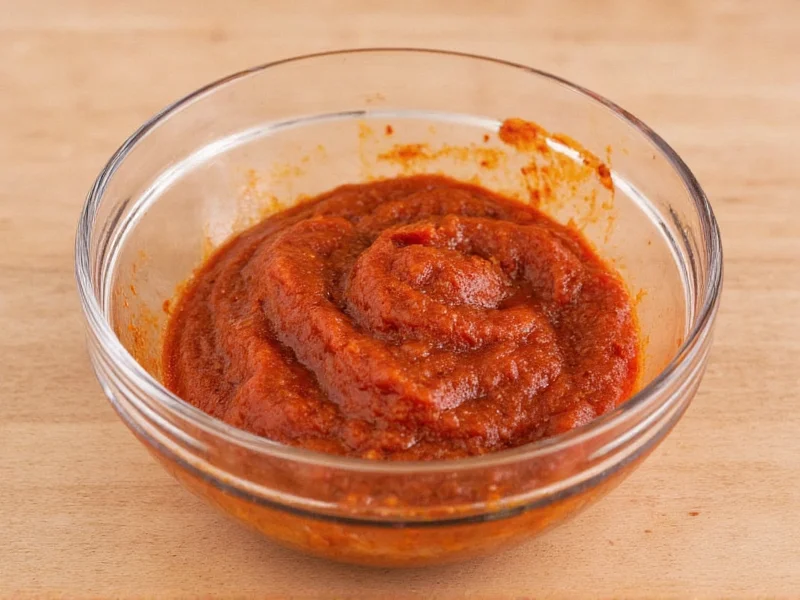The best chipotle paste substitutes include: 1) A blend of smoked paprika, tomato paste, and vinegar (1:1 ratio); 2) Finely minced chipotle peppers in adobo sauce (use 1 pepper + 1 tsp sauce per tablespoon of paste); 3) Ancho chili powder with a dash of liquid smoke; 4) Harissa paste for similar heat profile; 5) Regular chili powder with smoked salt for mild dishes. Each substitute works best in specific recipes depending on required heat level and smokiness.
Running out of chipotle paste mid-recipe doesn't have to ruin your cooking plans. This smoky, spicy ingredient adds distinctive flavor to Mexican and Southwestern dishes, but several accessible alternatives can save your meal when you're missing this specialty item. Understanding what makes chipotle paste unique—smoked jalapeños blended with vinegar, spices, and often tomato—is key to finding the right replacement.
What Makes Chipotle Paste Special
Chipotle paste delivers a complex flavor profile combining moderate heat (2,500-8,000 Scoville units), deep smokiness from wood-smoked jalapeños, and subtle sweetness. Unlike regular chili powders, it contains moisture that integrates smoothly into sauces, marinades, and stews. When seeking a chipotle paste substitute for recipes, you're primarily replacing three elements: smoke flavor, moderate heat, and thick consistency.
Top 5 Chipotle Paste Substitutes Ranked
Not all alternatives work equally well in every dish. Consider these factors when choosing your replacement:
| Substitute | Ratio to Replace 1 Tbsp Paste | Best For | Flavor Match | Heat Level |
|---|---|---|---|---|
| Smoked paprika + tomato paste + vinegar | 1 tsp smoked paprika + 1 tsp tomato paste + 1/2 tsp vinegar | Soups, stews, sauces | ★★★★☆ | Mild-Medium |
| Chipotle peppers in adobo sauce | 1 pepper + 1 tsp sauce | Tacos, marinades, salsas | ★★★★★ | Medium-Hot |
| Ancho chili powder + liquid smoke | 1 tsp ancho powder + 1/4 tsp liquid smoke + water | Mild dishes, family meals | ★★★☆☆ | Mild |
| Harissa paste | 1:1 replacement | North African fusion dishes | ★★★☆☆ | Medium-Hot |
| Chili powder + smoked salt | 1 tsp chili powder + 1/4 tsp smoked salt + water | Quick fixes, mild recipes | ★★☆☆☆ | Mild |
Detailed Substitute Breakdown
Smoked Paprika and Tomato Paste Blend
This chipotle paste substitute for recipes works exceptionally well in tomato-based dishes like enchilada sauce or chili. Combine equal parts smoked paprika and tomato paste with a splash of vinegar or lime juice. For every tablespoon of chipotle paste required, use one teaspoon each of smoked paprika and tomato paste plus half a teaspoon of vinegar. This creates a similar texture while delivering that essential smokiness without overwhelming heat—perfect for sensitive palates.
Chipotle Peppers in Adobo Sauce
When wondering what can I use instead of chipotle paste, look no further than the peppers themselves. Finely mince one chipotle pepper from adobo sauce and mix with one teaspoon of the sauce for each tablespoon of paste needed. This provides the most authentic flavor but tends to be hotter, so adjust quantities based on your heat tolerance. Ideal for marinades and salsas where visible pepper flecks enhance presentation.
Ancho Chili Powder Alternative
For those seeking a mild chipotle paste substitute, ancho chili powder offers comparable earthiness with less heat. Mix one teaspoon ancho powder with a quarter teaspoon liquid smoke and enough water to create a paste. Anchos come from dried poblano peppers, providing fruitier notes than chipotles but maintaining that characteristic Mexican cuisine depth. This works particularly well in dishes for children or those sensitive to spice.
Harissa Paste Option
Though North African rather than Mexican, harissa paste makes a surprisingly effective chipotle paste alternative when used judiciously. Its roasted red pepper base with garlic and spices creates a similar heat profile. Use equal amounts but reduce other spices in your recipe since harissa contains additional seasonings. Best reserved for fusion dishes where Mediterranean flavors complement your main ingredients.
Basic Chili Powder Solution
In a pinch, regular chili powder with smoked salt creates an emergency chipotle paste replacement. Combine one teaspoon chili powder with a quarter teaspoon smoked salt and enough liquid to form a paste. While lacking complexity, this works for dishes where chipotle plays a supporting rather than starring role. Add a pinch of cumin to enhance the earthy notes when using this quick fix.
How to Adjust Recipes When Substituting
Understanding chipotle paste substitute ratios prevents recipe disasters. When replacing chipotle paste in cooking:
- Start with 75% of the recommended substitute amount, then adjust to taste
- Add acidic components (vinegar, lime juice) gradually to balance flavors
- For slow-cooked dishes, add substitutes later in cooking to preserve flavor integrity
- When using hotter alternatives like harissa, reduce other spicy elements
Remember that chipotle paste contributes moisture to recipes. If using dry substitutes like chili powder, compensate with additional liquid—typically one to two teaspoons per tablespoon of paste replaced—to maintain proper sauce consistency.
Making Your Own Chipotle Paste
For those who frequently need chipotle paste alternatives, making your own ensures consistent quality. Blend 4-5 chipotle peppers from adobo sauce with 2 tablespoons of the adobo sauce, one small roasted red pepper, and a squeeze of lime until smooth. Store in an airtight container in the refrigerator for up to three weeks or freeze in ice cube trays for longer storage. This homemade version gives you complete control over heat level and ingredients.
Storage Tips for Substitutes
Most chipotle paste substitutes don't keep as long as commercial paste. Smoked paprika blends last about one week refrigerated, while homemade versions using fresh peppers should be used within three days. Freeze portions in silicone molds for quick access—these frozen substitutes work perfectly in cooked dishes without thawing. Always label containers with date and heat level since potency diminishes over time.











 浙公网安备
33010002000092号
浙公网安备
33010002000092号 浙B2-20120091-4
浙B2-20120091-4